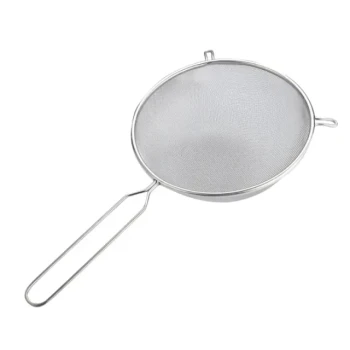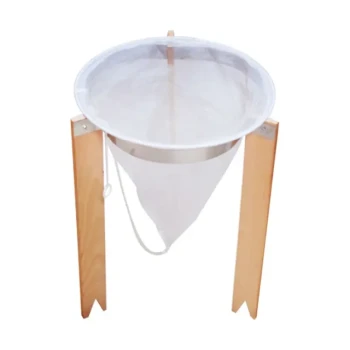When processing honey, the choice of material for your equipment is paramount. Stainless steel is the preferred material for honey strainers because its chemical composition makes it durable, resistant to rust, and completely food-safe, ensuring it does not react with the honey or alter its natural purity and flavor. Its non-porous surface also makes it exceptionally easy to clean and sanitize, which is critical for repeated use.
The decision to use stainless steel goes beyond simple durability. It is a fundamental choice to protect the integrity of the honey, preventing chemical reactions and contamination that can occur with lesser materials.

The Critical Properties of Stainless Steel
To understand why stainless steel is the industry standard, we must look at how its properties directly counter the challenges of working with honey.
Corrosion and Rust Resistance
Honey is naturally acidic and contains a small amount of water. This combination can be surprisingly corrosive to many metals over time. Stainless steel is an alloy containing chromium, which creates a passive, invisible layer on the surface that resists oxidation and rust, even with prolonged exposure to acidic honey.
This resistance is not just about aesthetics; it is about preventing rust particles and metallic compounds from contaminating your final product.
Non-Reactive and Food-Safe
The most important quality of any food-contact surface is that it remains inert. Stainless steel does not leach chemicals, alloys, or metallic flavors into the honey. This ensures the honey's delicate and complex flavor profile remains exactly as the bees produced it.
This non-reactive quality is why specific grades of stainless steel (like 304 or 316) are universally approved for food processing environments.
Unmatched Durability and Longevity
Honey processing can be a demanding physical task. Stainless steel strainers are rigid and robust, capable of withstanding the weight of heavy honey flows without warping, cracking, or breaking.
While other materials may degrade over time, a stainless steel strainer is a long-term investment that can last for decades with proper care.
Ease of Cleaning and Sanitization
A clean operation is essential for producing high-quality honey. Stainless steel has a smooth, non-porous surface that leaves no place for bacteria, wax, or pollen to hide. It can be easily washed with hot water and sanitized effectively, preventing the introduction of microorganisms that could lead to fermentation or spoilage.
Understanding the Trade-offs
While stainless steel is the superior technical choice, it is important to consider the practical alternatives and their associated compromises.
The Question of Cost
The primary drawback of stainless steel is its higher upfront cost compared to other options. This initial investment can be a significant consideration, especially for hobbyists or small-scale beekeepers. However, this cost is often justified by its extreme longevity and reliability.
Alternatives: Nylon and Plastic Strainers
Nylon or food-grade plastic strainers are common and much more affordable. They are lightweight and functional for basic filtration.
However, they come with distinct disadvantages. Plastic is softer and can be scratched, creating microscopic crevices where bacteria can accumulate. Over time, plastic can also absorb odors or pigments and may become brittle with age or exposure to heat and UV light.
Making the Right Choice for Your Operation
Your decision should be based on the scale of your operation and your long-term goals.
- If your primary focus is professional quality and long-term investment: A food-grade stainless steel strainer is the only logical choice for its durability, cleanability, and purity assurance.
- If your primary focus is hobby-level beekeeping or minimizing initial cost: A nylon strainer is a functional starting point, but be diligent about cleaning and plan to replace it as it ages.
Ultimately, selecting your equipment material is a direct investment in the quality and safety of your honey.
Summary Table:
| Key Advantage | Why It Matters for Honey Processing |
|---|---|
| Corrosion & Rust Resistance | Withstands honey's natural acidity, preventing contamination. |
| Non-Reactive & Food-Safe | Preserves the honey's natural flavor and purity. |
| Durability & Longevity | A long-term investment that withstands heavy use. |
| Easy Cleaning & Sanitization | Non-porous surface prevents bacterial growth and spoilage. |
Equip your apiary with the industry's best. For commercial apiaries and beekeeping equipment distributors, the quality of your equipment directly impacts the quality of your honey. HONESTBEE supplies professional-grade, food-safe stainless steel honey strainers and other essential beekeeping supplies through our wholesale-focused operations. Ensure the purity and integrity of your product with durable, easy-to-clean equipment built to last. Contact HONESTBEE today to discuss your wholesale needs and elevate your honey processing standards.
Visual Guide

Related Products
- Professional Stainless Steel Honey Filter with Support Handle
- Professional Honey Filter with Tripod Support Stand
- Professional Dual-End Stainless Steel Hive Tool for Beekeeping
- Multi-Function Plier-Style Frame Grip Hive Tool
- Professional Stainless Steel Pry-Bar Hive Tool
People Also Ask
- What is the process of filtration in honey processing? A Guide to Purity & Shelf Life
- What can I use to sieve honey? The Essential Tool for Clean, High-Quality Honey
- Is it necessary to filter honey after extraction? A Guide to Straining vs. Raw Honey
- What Micron is best for filtering honey? Choose the Right Filter for Show-Quality or General Sales
- What are the types of honey filters and their uses? Choose the Right System for Your Scale



















